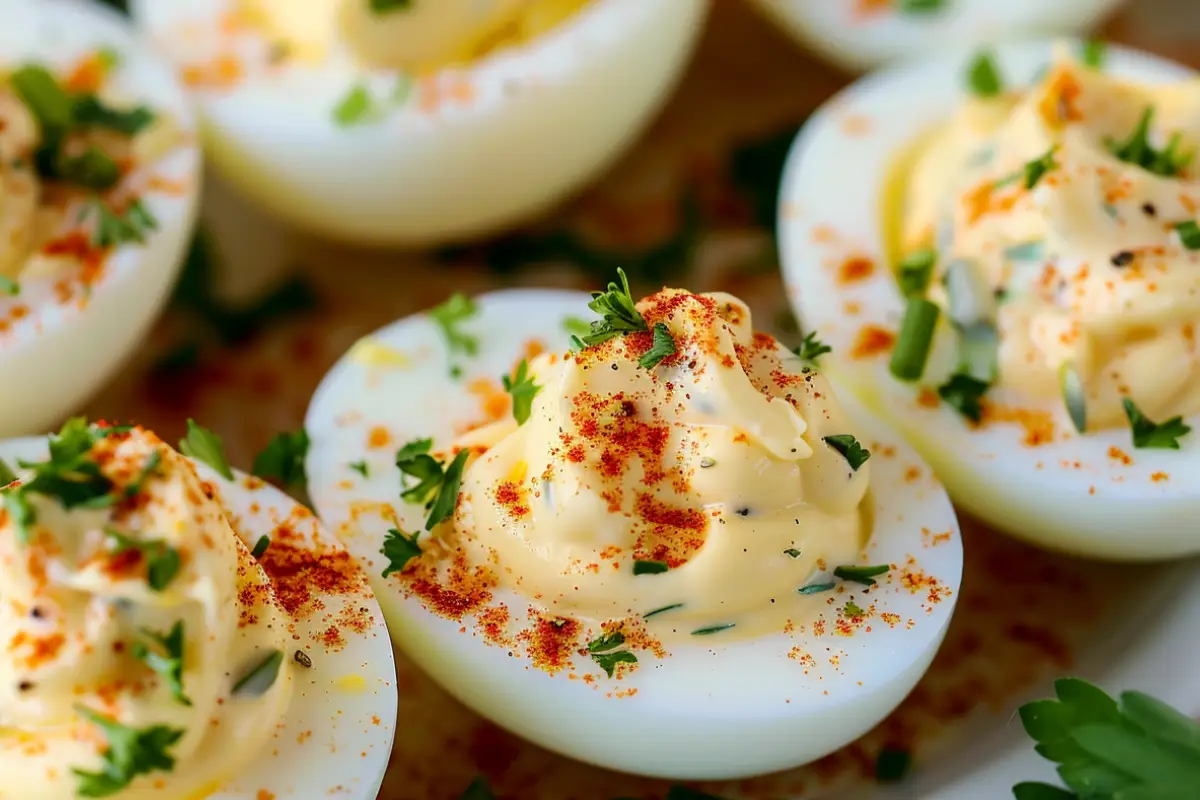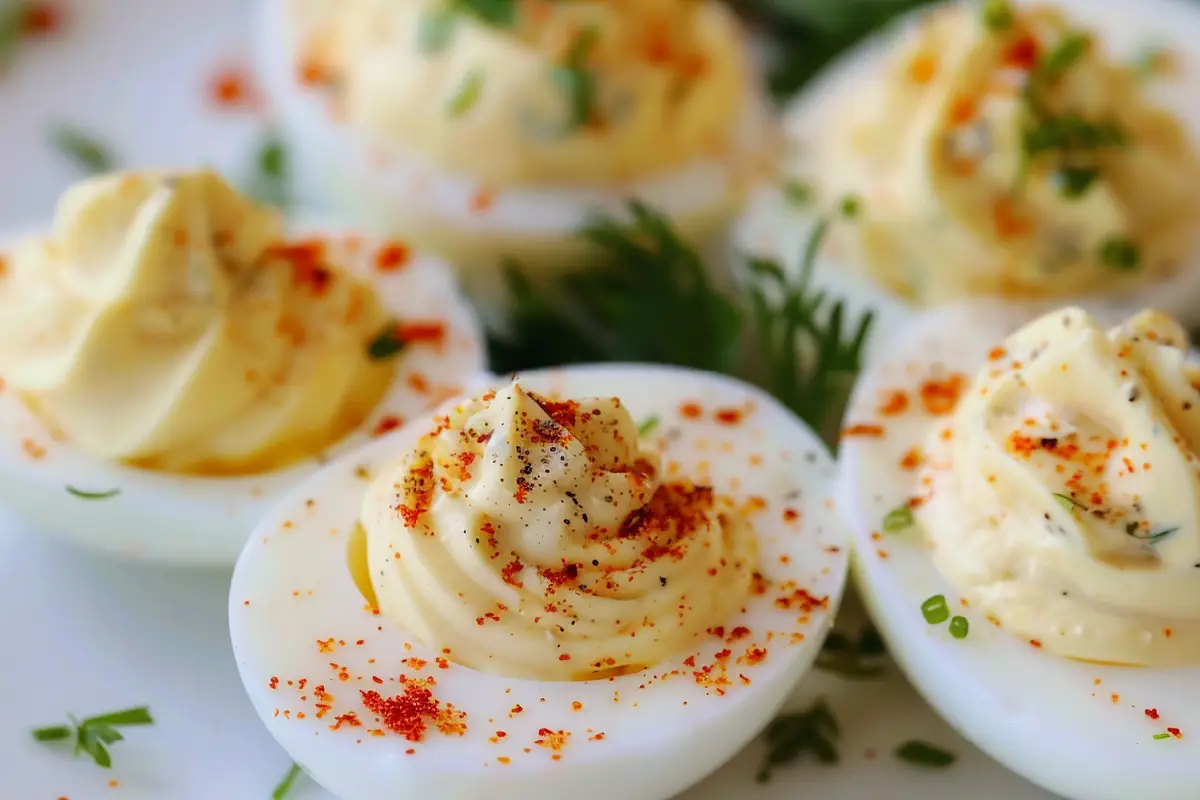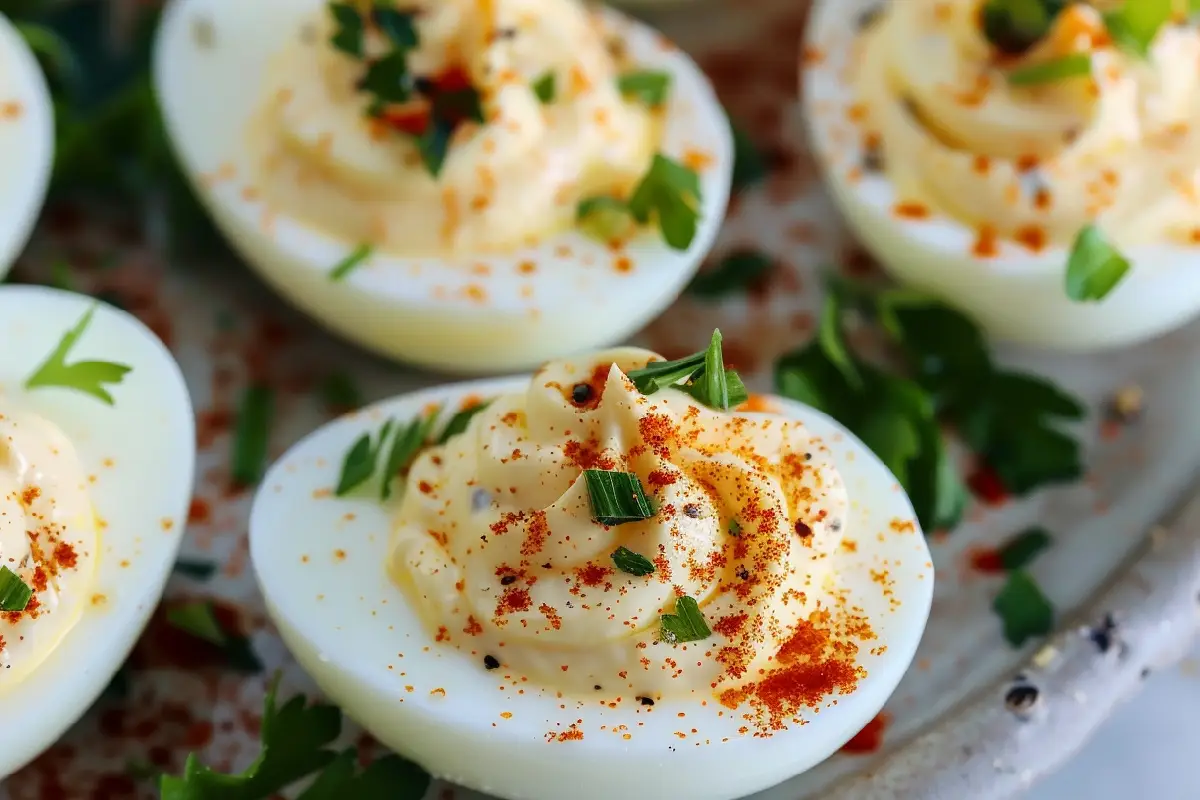Deviled eggs are a beloved appetizer that often graces tables during family gatherings, holiday dinners, and picnics. Known for their creamy, tangy filling, deviled eggs are adaptable to different tastes and preferences. One ingredient that often sparks debate is relish. Some recipes include this sweet and crunchy condiment, while others stick to a more traditional approach. So, do deviled eggs contain relish, and what role does it play in enhancing the flavor and texture of this popular snack?
A Brief History of Deviled Eggs
The concept of deviled eggs dates back to ancient Rome, where people seasoned boiled eggs with spicy sauces and served them as a starter dish. The term “deviled” originated in the 18th century, describing foods that were highly seasoned, often with mustard, pepper, or other bold spices. Heavily spiced foods were seen as exotic and sophisticated during that time. By the 19th century, the modern version of deviled eggs, featuring a creamy yolk mixture, had become popular in Europe and the United States.
In the Southern United States, cooks often add sweet relish to deviled eggs, giving the dish a distinct flavor. This twist reflects the Southern love for balancing sweet and tangy flavors, as seen in many traditional dishes. For a deeper dive into this Southern twist, explore recipes like Tangy Deviled Eggs with Relish, which highlight how relish can elevate the overall taste of deviled eggs.
Traditional Deviled Egg Ingredients

At their core, deviled eggs combine a few simple ingredients to create a delicious, crowd-pleasing appetizer. These basic ingredients include:
-
Hard-boiled eggs: The foundation of the dish, providing the whites and yolks that make up the filling.
-
Mayonnaise: Adds creaminess, moisture, and richness to the filling.
-
Yellow mustard: Brings a tangy, slightly spicy element that cuts through the richness of the mayonnaise.
-
Salt and pepper: Essential seasonings that enhance the overall flavor.
-
Paprika: Typically used as a garnish, adding color and a mild smoky flavor.
These ingredients form the classic deviled egg filling, but many variations exist. Adding sweet relish introduces a new layer of complexity, enhancing the dish with a balance of sweet and tangy notes. Relish makes each bite more exciting, offering a pleasant contrast in texture and flavor. For those who love to pair appetizers with comfort food, deviled eggs go perfectly with sides like Cheesy Mashed Potatoes, creating a rich and indulgent combination.
The Role of Relish in Deviled Eggs
Relish is a condiment made from chopped pickles, vegetables, or fruits combined with vinegar, sugar, and spices. Most often, deviled eggs use sweet relish, which adds a mild sweetness and crunchy texture to the filling. This ingredient can significantly change the flavor profile of deviled eggs, making them stand out from the traditional version.
Benefits of Adding Relish:
- Enhanced Flavor: Relish balances the tanginess of mustard and the richness of mayonnaise, blending sweet and savory notes.
- Added Texture: The crunchy bits of relish contrast with the smooth filling, making each bite more satisfying.
- Visual Appeal: Relish adds small flecks of green and other colors, making the deviled eggs look more vibrant.
Drawbacks of Adding Relish:
- Overpowering Sweetness: For those who prefer a savory deviled egg, the sweetness of relish can overwhelm the flavors.
- Deviation from Tradition: Some purists argue that adding relish moves away from the traditional recipe, which focuses on savory flavors.
Regional Variations in Deviled Eggs
While sweet relish is common in Southern-style deviled eggs, regional variations bring different ingredients to the table. In the Midwest, cooks often use chopped pickles or dill relish, which offers a tangier and less sweet alternative. In Northern states, capers or finely chopped olives are sometimes added, bringing salty notes that enhance the creamy filling.
These regional adaptations show how versatile deviled eggs can be. For instance, Southern versions balance sweet and tangy flavors, reflecting broader culinary trends in the region. Meanwhile, Northern variations emphasize savory and briny flavors, offering a unique twist that stands apart from the Southern approach.
Relish Substitutes in Deviled Eggs
If you’re not fond of sweet relish or want to experiment, several substitutes can provide a similar texture and flavor:
- Chopped Pickles: Dill pickles, bread and butter pickles, or spicy pickles can be used as alternatives, each offering different levels of sweetness and tanginess.
- Capers: Small and briny, capers add a salty, tangy flavor that pairs well with the creamy yolk mixture.
- Olives: Green or black olives, finely chopped, provide a bold, briny contrast that enhances the dish.
These substitutes allow you to tweak your deviled eggs to suit your tastes while still maintaining the added texture that relish provides.
How to Make Deviled Eggs with Relish
Making deviled eggs with relish is easy and only requires a few extra steps compared to the traditional recipe. Follow this simple guide to make them at home:
Ingredients:
- 6 large hard-boiled eggs
- ¼ cup mayonnaise
- 1 teaspoon yellow mustard
- 2 tablespoons sweet relish
- Salt and pepper to taste
- Paprika, dill, or chives for garnish
Instructions:
- Slice the hard-boiled eggs in half lengthwise and remove the yolks, placing them in a bowl.
- Mash the yolks with a fork until smooth, breaking up any large lumps.
- Mix in the mayonnaise, mustard, relish, salt, and pepper until well combined.
- Spoon or pipe the yolk mixture back into the egg whites, filling each half generously.
- Garnish with paprika, dill, or chives for extra flavor and presentation.
Tips for Perfect Deviled Eggs
To make sure your deviled eggs turn out great every time, keep these tips in mind:
- Use fresh eggs: Fresh eggs peel more easily after boiling, keeping the egg whites smooth and intact.
- Avoid overcooking: Overcooked eggs develop a greenish ring around the yolk and a rubbery texture. Boil for 10-12 minutes and then cool quickly in ice water.
- Drain the relish: Excess liquid can make the filling runny. Drain the relish thoroughly to maintain the right consistency.
- Pipe the filling: Use a piping bag for a professional look. It ensures even distribution and makes the eggs look more appealing.
Common Mistakes When Adding Relish
When adding relish to deviled eggs, avoid these common mistakes to ensure the best results:
- Using too much relish: Start with a small amount and adjust to taste, so the filling doesn’t become too sweet.
- Not draining the relish: Wet relish dilutes the filling, making it less creamy. Drain well to keep the texture smooth.
- Overmixing: Keep the texture light and airy. Overmixing can make the filling dense, losing the fluffiness that makes deviled eggs appealing.
Creative Variations of Deviled Eggs with Relish
Deviled eggs are highly customizable, allowing for endless flavor combinations. Here are some creative variations that incorporate relish and other unique ingredients:
- Deviled Eggs with Bacon and Relish: Add crispy bacon bits to the filling or as a topping for a smoky crunch. The saltiness of the bacon balances the sweetness of the relish, creating a rich and savory combination.
- Spicy Deviled Eggs: Add chopped jalapeños, a dash of hot sauce, or spicy relish for extra heat. The combination of spicy and sweet flavors adds a bold twist to the classic recipe.
- Avocado Deviled Eggs: Replace some of the mayonnaise with mashed avocado for a healthier, creamier filling. Avocado adds a fresh flavor and a vibrant green color, making the dish feel modern and nutritious.
These variations introduce new flavors and textures, turning the traditional deviled egg into a delightful and unique appetizer.
Health Considerations
Deviled eggs provide a good source of protein, healthy fats, and essential nutrients, but the added ingredients can affect their nutritional profile. Here are some health considerations:
- Caloric Content: Mayonnaise and relish add calories, which can be significant if consumed in large amounts. Use low-fat mayonnaise or substitute Greek yogurt for a lighter alternative with fewer calories.
- Sodium Levels: Mustard, relish, and salt can contribute to higher sodium levels. For a low-sodium option, choose reduced-sodium versions of these condiments or adjust the amounts.
- Healthy Swaps: For a healthier twist, try replacing mayonnaise with mashed avocado or Greek yogurt. These options add beneficial fats and nutrients without compromising taste.
FAQs About Deviled Eggs and Relish

Do all deviled eggs recipes include relish?
Not all recipes include relish. It’s particularly common in Southern-style variations, but many traditional recipes opt for a simpler, relish-free filling.
What kind of relish is best for deviled eggs?
Sweet relish is the most popular, adding a touch of sweetness and crunch. However, dill relish or other pickled vegetables can also be used for a tangier flavor.
Can I substitute relish in deviled eggs?
Yes, you can substitute relish with chopped pickles, capers, or olives to achieve a similar texture and enhance the flavor profile.
Why are they called deviled eggs?
The term “deviled” refers to the spicy or zesty nature of the seasonings traditionally used, like mustard and pepper, which became popular in the 19th century.
Are deviled eggs healthy?
Deviled eggs can be healthy when eaten in moderation, offering protein and healthy fats. However, depending on the ingredients, they can also be high in calories and sodium.
Conclusion
Adding relish to deviled eggs introduces a delightful twist, enhancing the flavor and texture of this classic dish. Whether you stick to the traditional recipe or enjoy trying new variations, deviled eggs remain a versatile appetizer that can be tailored to suit any taste. So next time you prepare deviled eggs, don’t hesitate to experiment with relish or other unique ingredients to create your perfect version of this timeless favorite!

